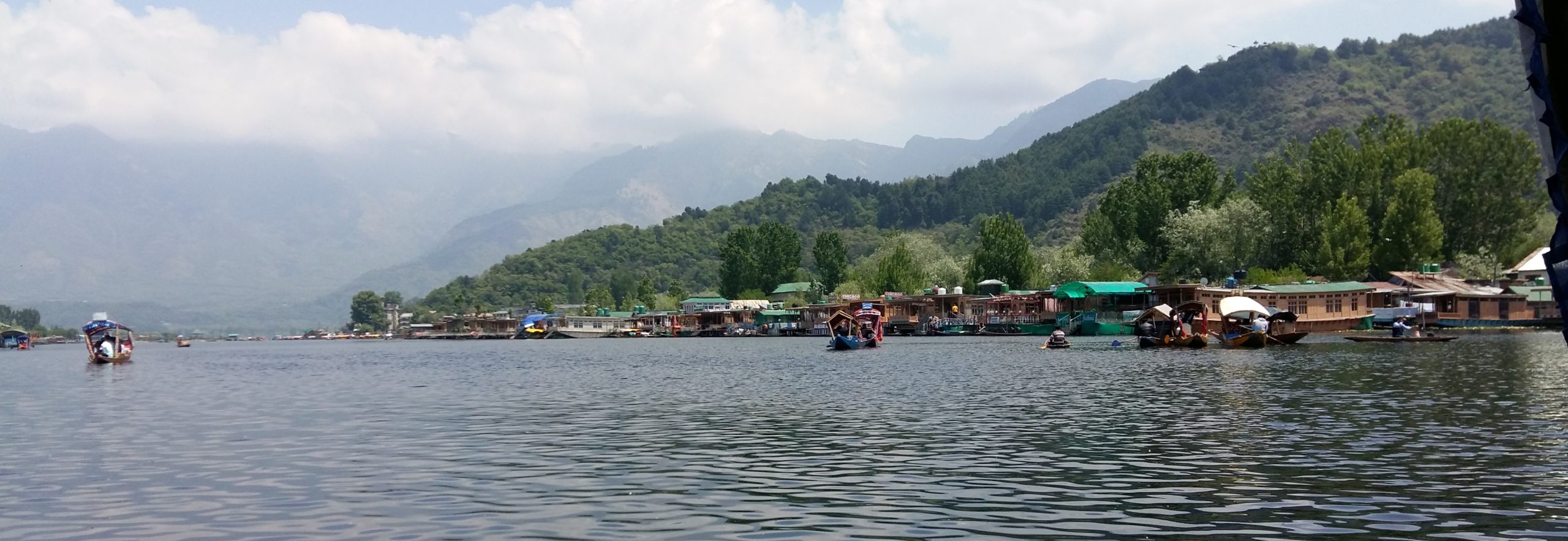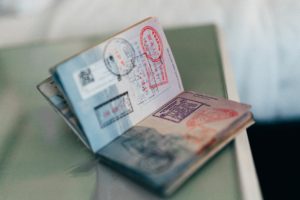Reservation and Payment
For our tour packages and flight bookings we offer payment via PayPal, Direct Bank Transfer, and through our partner Razorpay all major credit cards, netbanking, wallets and UPI.
For Direct Bank Transfers to our Indian company account, we recommend using payment services like wise.com (formerly transferwise) or worldremit.com which make an international transfer both cheaper and easier.
For walk-in clients we also offer paying in cash.
No, all prices are inclusive of all fees and taxes.
Yes, we do. Please contact us.
Please check point no. 3 in our terms & conditions.
We kindly request you to make a booking for a package between 7-365 days in advance. Please contact us for any other service or request.
Staying in Kashmir
The currency in the Kashmir valley is Indian Rupees (₹/INR), like in all other parts of India. You can check the value of INR compared to your country’s currency here.
In bigger shops, restaurants or hotels you will probably be able to pay with credit card, but it is recommendable to always carry a good amount of cash here.
Yes, ATMs are available nearly everywhere. The maximum amount that can be withdrawn at once is currently INR 10,000. Depending on the limit on your card you may be able to do several withdrawals at the same ATM. According to our experience, the ATMs of HDFC Bank work most reliably with foreign cards.
Yes. Some banks also offer currency exchange, but the conversion rate is usually a little below the rate of local exchange companies (like UAE Xchange).
Officially the voltage in India is 220-240 V / 50 Hz. You can check here to see if this is the same as in your country. In reality, however, it is often lower. Furthermore, there are usually power cuts several times during the day, usually for an hour each. Hotels have storage batteries to cover these power cuts. Charging electrical devices like mobile phones or laptops is usually not a problem. Using other electrical appliances like a hairdryer or iron, which need more power, may not always be possible.
The plugs are of type C, E and M – see https://www.power-plugs-sockets.com/india/.
The official languages of Kashmir are Urdu and Kashmiri, in written form it is English. Urdu is about eighty percent identical with Hindi, just using a different script. In most hotels and restaurants communication in English will not be a problem. The younger generation often speaks all three languages fluently.
Please contact us if you are interested in receiving some basic vocabulary and/or phrases in Urdu/English, Urdu/German.
Kashmir has 4 seasons: winter (December-February), spring (March-May), summer (June-August), fall/autumn (September-November).
January is the coldest month (sometimes down to -10 °C/14 °F, on average 1.5 °C / 34.7 °F), July the hottest (sometimes up to 35 °C/95 °F, on average 24.6 °C / 76.3 °F).
March has the highest rainfall with up to 110mm, November the lowest rainfall with about 24mm.
The main travel season is between March and September, except for ski holidays, which are available in winter.
For more detailed climate data referring to Srinagar click here.
Kashmir has been a conflict region for many years, and some countries have issued travel advisories regarding this region. However, as German foreigners who live here, we generally experience it as safe to be and live here. Kashmir is receiving several hundred thousand tourists a year (2010: 736.000), and tourists are not a target for either conflict party. What you could experience is one or several days of strike with closed shops and schools, and sometimes blocked social media or cut internet.
Good up-to-date information about Kashmir can be found on https://www.greaterkashmir.com/.
No, the tap water is not potable in Kashmir or other parts of India. We recommend to only drink filtered, disinfected or boiled water, or water out of new bottles.
Since the Kashmir valley is a predominantly Muslim region, alcohol is usually not available.
In general yes, but we recommend foreign visitors to eat only foods that have been boiled, cooked or peeled.
For Indian Nationals: Usually only “Post-Paid” SIM cards are working in Kashmir.
For foreigners: You will be able to use a foreign SIM-card in Delhi and other places of India (with the specific roaming charges), but NOT in Jammu & Kashmir. Even Indian pre-paid SIM-cards do not work here.
Some providers like Jio and Airtel may be able to provide you with an official “Tourist-SIM Card”. If you want to purchase one, go to an official store of one of these providers and ask if they have a tourist-SIM available. You will definitely need your original passport/visa and a copy of each, and you may also need a passport photograph. Expect it to take some time until the SIM gets activated.
The best way for foreigners to communicate is by connecting to wifi in the hotel or other places.
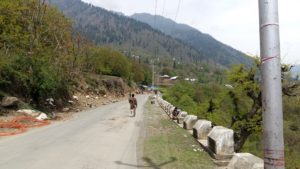 The condition of roads in Kashmir is not comparable to countries like Germany. Except on the highway, plan an average travel speed of 30 km/h. Especially if you’re riding a scooty or motorcycle be aware of larger holes in the road, and of unmarked speed bumpers. Roads are usually used by cars, trucks, auto-rickshaws, motorcyclists, cyclists and people walking at the same time, so drive carefully, and honk whenever you overtake someone, since people might not be looking into the backmirror. Also be aware that people may overtake you from both the left and the right side.
The condition of roads in Kashmir is not comparable to countries like Germany. Except on the highway, plan an average travel speed of 30 km/h. Especially if you’re riding a scooty or motorcycle be aware of larger holes in the road, and of unmarked speed bumpers. Roads are usually used by cars, trucks, auto-rickshaws, motorcyclists, cyclists and people walking at the same time, so drive carefully, and honk whenever you overtake someone, since people might not be looking into the backmirror. Also be aware that people may overtake you from both the left and the right side.
General Information
Respecting the local culture, we would recommend ladies to wear dresses which cover legs and arms (or at least the shoulders). Wear rather loose-fitting dresses and clothes with normal necklines, and nothing see-through.
For men we recommend to cover at least the shoulders and wear normal necklines. If wearing shorts in public, have them cover at least your knees.
Ladies should cover their head with a scarf when visiting religious sites.
Winter Season: Special Clothing-Notice
When you come during the months of May to October, Kashmir demands some warm clothing. The following is especially true for Gulmarg:
If you intend to reach Kangdori/Kongdoori station (about 3050 m) or even Apharwat station (about 3950 m), you do want to have a warm jacket/coat or even a (woolen) cap handy to put on in case you feel cold. We also recommend waterproof clothing or an umbrella and walking/hiking shoes – please leave your high heeled shoes at home this time :). Due to the intense sunbeams, we also recommend sun glasses.
During the months of November to April you all want to have the above, plus at least an additional layer of clothing for both upper and lower part of your body and gloves.
If you want to rent a jacket or rubber boots, the best address for Gulmarg may be the main market (each around Rs85/-) – or even your hotel.
Special info on skiing / snowboarding in Gulmarg
Gulmarg is known as a Powder Snow Paradise. If you’re a winter sport fan, not only in watching, but also in practicing, Gulmarg is a “must go” place in India. The possibility of skiing down from 3950 meters above sea level, and over a distance of maybe 1300 m, should speak for itself!
What is the best time for travelling to Gulmarg for skiing?
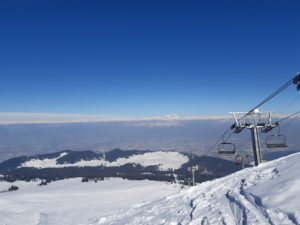 For the months of January and February we can give a 95 % guarantee that you will experience the best snow you can get up there. But depending on the weather, the skiing season in Gulmarg can already start in November and lead up to April.
For the months of January and February we can give a 95 % guarantee that you will experience the best snow you can get up there. But depending on the weather, the skiing season in Gulmarg can already start in November and lead up to April.
Can I rent ski equipment in Gulmarg?
In case you’re a beginner or just do not want to carry along your ski equipment, there are locations in Gulmarg where you can rent your entire ski or snowboard set. We recommend the “Government Ski Shop”, which is about 600 m away from the main Gondola building. Depending on your needs you can get ski equipment for Rs. 300/- per day as an Indian National (IN), Rs. 400/- per day as a Foreign National (FN). Special powder ski are around Rs. 700/- per day , and a snowboard Rs. 500/- per day. Students can get a 50% discount. As far as we know ski helmets cannot be rented – we highly recommend to bring one along.
Skiing infos for beginners:
there are two T-bar lifts at the already mentioned “Government Ski Shop” which provide a very good first-step training field (Rs. 200/- per day and person).
Beginners can get skiing instructors on site (Rs. 600/- per day a person).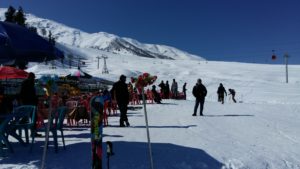
Skiing infos for experts:
depending on how much or how long you plan to ski, there are a variety of tariffs available, and you have the two phases of the gondola and one chairlift to choose from. We recommend to start with the Phase 1 Gondola (Gulmarg to Kangdori) if you know how to ski but haven’t done so for a while. A next step from there is the Kangdori chairlift to “Mary’s Shoulder”, and if you’ve managed that well, the next possibility for going up even higher is the Phase 2 Gondola (Kangdori to Apharwat). If you do not need to worry about money: Gulmarg offers heli-skiing, though this may be situational.
Coming back to tariffs, a day pass for Phase 1 costs around Rs. 740/- for IN and Rs. 1210/- for FN, a day pass for Phase 2 is Rs. 1210/- for IN and Rs. 1900/- for FN. Weekly passes for Phase 1: Rs. 3150/ IN, Rs. 5350/ FN; weekly passes for Phase 2: Rs. 7130/ IN, Rs. 9490/ FN).
If you want to powder ski outside of the prepared slopes and have never been to Gulmarg, you can get a local ski guide for about Rs.2500/- per day a person.
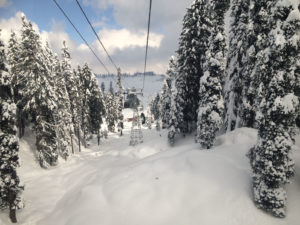 If you are an expert, we recommend you get a Phase 2 day/weekly pass. This will usually permit you to use Phase 1 for one trip up to Kangdori station. In addition it permits you to use the Kangdori chairlift (KCL) as often you like, and the Phase 2 gondola of course. At the end of the day you can ski down all the way to Gulmarg, back to your hotel. Phase 2 may get closed due to heavy storms and/or other reasons, if this is the case, your Phase 2 ticket would very likely be valid for Phase 1 “until further notice”.
If you are an expert, we recommend you get a Phase 2 day/weekly pass. This will usually permit you to use Phase 1 for one trip up to Kangdori station. In addition it permits you to use the Kangdori chairlift (KCL) as often you like, and the Phase 2 gondola of course. At the end of the day you can ski down all the way to Gulmarg, back to your hotel. Phase 2 may get closed due to heavy storms and/or other reasons, if this is the case, your Phase 2 ticket would very likely be valid for Phase 1 “until further notice”.
An important info regarding avalanches:
if you ski between Kangdori and Apharwat (Phase 2) we highly recommend to carry along an “avalanche airbag” backpack for backcountry trips, and to check regularly with the local staff how the situation is. At best don’t go alone and don’t drink alcohol during skiing.
Travel Preparation
Recommended packing list:
- Documents:
- Personal medication and first aid kit, including sun screen
- Small first-aid kit
- Personal toiletries
- Hiking boots/shoes/sandals – according to the time of the year and your intentions for your stay here.
- Flip-flops/thongs for using Indian bathrooms and shower, although these are being provided in most cases
- Jacket(s)/ warm sweaters
- Rain jacket
- T-shirts
- Underwear
- Socks
- Trousers
- Shawl (for women wanting to enter religious sights – you can also buy a shawl, called “dupatta,” in a local shop here)
- Depending on where you intend to stay and if you prefer: your own bedsheet, pillowcase, duvet cover; sleeping bag
- Small umbrella
- Backpack
- Mobile phone/camera
- Sun hat
- torch/flashlight
- Ladies: feminine hygiene products (tampons are hardly available)
- Hairdryer, if you need one
- a travel adapter, depending on the country you’re from
If you travel here outside the summer season, we recommend bringing some more warm clothes to wear underneath or on top, since houses and hotels usually don’t have central heating.
If you’re not an Indian citizen or OCI (Overseas Citizen of India, with the respective documents) you need a visa for entering India, with very few exceptions (check here). For stays that don’t exceed 90 days, an e-tourist visa, which is available for the citizens of most countries, is the best option. Application is online on https://indianvisaonline.gov.in/evisa/tvoa.html.
Please see “How to apply for an e-visa” in our FAQs for further information regarding the application process.
If you want us to help you with your visa application, please contact us.
You need to carry a copy of the Electronic Travel Authorization you will receive after a successful e-tourist visa application for entering India. Please confirm before your journey that the visa status is shown as “granted” on the indianvisaonline-Website.
If you’re a foreign national, you need to fill out a special form at the Foreign Registration Counter opposite the entry/exit door at both arrival and departure from Srinagar airport (SXR).
You can fill out the form when you get there OR you can download the files as PDF from the following links, print them out and fill them in beforehand…
Registration Form For Foreigner Nationals On Arrival
Registration Form For Foreigner Nationals On Departure
Some protected areas within the region require an extra permit (check here), but none of these are part of our tours.
The best airport to fly to on your international journey to India when wanting to visit Kashmir is Indira Gandhi International Airport in Delhi. The flight time from there to Srinagar is 1.5 hours. If you want us to book your domestic flight for you, from there or from another Indian airport, please contact us.
Depending on your time of arrival in Delhi, it is possible that you will have an overnight stay there. Please check here for further information on arrival in Delhi and possible hotel options if you have an overnight stay there.
If you want to go the adventurous way, you can also travel by train and road. The destination train station is Jammu Tawi (JAT), then you need to continue by bus or taxi to the train station Banihal (BAHL), after that by train to the train station Srinagar (SINA).
To travel entirely by road is also possible, but takes even longer and is likely to be even more adventurous than travelling by train and road. The destination in that case is the Srinagar Tourist Reception Center (TRC), by bus or taxi.
We recommend that you travel by plane.
You’re not legally required to have a travel insurance, but we highly recommend that you have a policy if you’re coming from abroad, optimally one that also covers a transport back to your home country in case of any medical emergency. Hospitals and doctors are available here, but their standard may be lower than you’re used to, depending on the country you’re from. If you want us to purchase one for you, please contact us.
A yellow fever vaccination is a requirement for entering India if you have been staying in a yellow fever zone within six days before coming here. This is mostly relevant for people who have stayed in an African or South American country during this time. Please check https://www.who.int/ith/en/ for information on yellow fever risk areas. This website https://www.fitfortravel.nhs.uk/advice/disease-prevention-advice/yellow-fever/yellow-fever-risk-areas could also be helpful.
Apart from that, the German Robert Koch Institute recommends the following vaccinations for short-term travel in India:
- Hepatitis A
- Typhus
- Poliomyelitis
Malaria or Dengue is not a danger in the altitude levels of Kashmir. If you’re also staying in other parts of India at lower altitudes, taking Malaria prophylaxis and getting a vaccination against Dengue fever is worth considering.
Yes, they are. However, if you need to take a specific medication regularly, we recommend you to bring it in an amount that is sufficient for your entire trip.
The application for an e-Visa for India can be made on https://indianvisaonline.gov.in/evisa/tvoa.html.
An e-Visa is usually the easiest and cheapest way to get a visa for your trip to India.
Citizens of the following countries are eligible to apply for an e-visa:
Albania, Andorra, Angola, Anguilla, Antigua & Barbuda, Argentina, Armenia, Aruba, Australia, Austria, Azerbaijan, Bahamas, Barbados, Belarus, Belgium, Belize, Benin, Bolivia, Bosnia & Herzegovina, Botswana, Brazil, Brunei, Bulgaria, Burundi, Cambodia, Cameroon Union Republic, Canada, Cape Verde, Cayman Island, Chile, China, China- 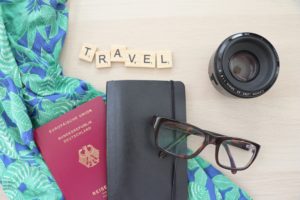 SAR Hongkong, China- SAR Macau, Colombia, Comoros, Cook Islands, Costa Rica, Cote d’lvoire, Croatia, Cuba, Cyprus, Czech Republic, Denmark, Djibouti, Dominica, Dominican Republic, East Timor, Ecuador, El Salvador, Equatorial Guinea, Eritrea, Estonia, Fiji, Finland, France, Gabon, Gambia, Georgia, Germany, Ghana, Greece, Grenada, Guatemala, Guinea, Guyana, Haiti, Honduras, Hungary, Iceland, Indonesia, Iran, Ireland, Israel, Italy, Jamaica, Japan, Jordan, Kazakhstan, Kenya, Kiribati, Kyrgyzstan, Laos, Latvia, Lesotho, Liberia, Liechtenstein, Lithuania, Luxembourg, Madagascar, Malawi, Malaysia, Mali, Malta, Marshall Islands, Mauritius, Mexico, Micronesia, Moldova, Monaco, Mongolia, Montenegro, Montserrat, Mozambique, Myanmar, Namibia, Nauru, Netherlands, New Zealand, Nicaragua, Niger Republic, Niue Island, Norway, Oman, Palau, Palestine, Panama, Papua New Guinea, Paraguay, Peru, Philippines, Poland, Portugal, Qatar, Republic of Korea, Republic of Macedonia, Romania, Russia, Rwanda, Saint Christopher and Nevis, Saint Lucia, Saint Vincent & the Grenadines, Samoa, San Marino, Saudi Arabia, Senegal, Serbia, Seychelles, Sierra Leone, Singapore, Slovakia, Slovenia, Solomon Islands, South Africa, Spain, Sri Lanka, Suriname, Swaziland, Sweden, Switzerland, Taiwan, Tajikistan, Tanzania, Thailand, Tonga, Trinidad & Tobago, Turks & Caicos Island, Tuvalu, UAE, Uganda, Ukraine, United Kingdom, Uruguay, USA, Uzbekistan, Vanuatu, Vatican City-Holy See, Venezuela, Vietnam, Zambia and Zimbabwe
SAR Hongkong, China- SAR Macau, Colombia, Comoros, Cook Islands, Costa Rica, Cote d’lvoire, Croatia, Cuba, Cyprus, Czech Republic, Denmark, Djibouti, Dominica, Dominican Republic, East Timor, Ecuador, El Salvador, Equatorial Guinea, Eritrea, Estonia, Fiji, Finland, France, Gabon, Gambia, Georgia, Germany, Ghana, Greece, Grenada, Guatemala, Guinea, Guyana, Haiti, Honduras, Hungary, Iceland, Indonesia, Iran, Ireland, Israel, Italy, Jamaica, Japan, Jordan, Kazakhstan, Kenya, Kiribati, Kyrgyzstan, Laos, Latvia, Lesotho, Liberia, Liechtenstein, Lithuania, Luxembourg, Madagascar, Malawi, Malaysia, Mali, Malta, Marshall Islands, Mauritius, Mexico, Micronesia, Moldova, Monaco, Mongolia, Montenegro, Montserrat, Mozambique, Myanmar, Namibia, Nauru, Netherlands, New Zealand, Nicaragua, Niger Republic, Niue Island, Norway, Oman, Palau, Palestine, Panama, Papua New Guinea, Paraguay, Peru, Philippines, Poland, Portugal, Qatar, Republic of Korea, Republic of Macedonia, Romania, Russia, Rwanda, Saint Christopher and Nevis, Saint Lucia, Saint Vincent & the Grenadines, Samoa, San Marino, Saudi Arabia, Senegal, Serbia, Seychelles, Sierra Leone, Singapore, Slovakia, Slovenia, Solomon Islands, South Africa, Spain, Sri Lanka, Suriname, Swaziland, Sweden, Switzerland, Taiwan, Tajikistan, Tanzania, Thailand, Tonga, Trinidad & Tobago, Turks & Caicos Island, Tuvalu, UAE, Uganda, Ukraine, United Kingdom, Uruguay, USA, Uzbekistan, Vanuatu, Vatican City-Holy See, Venezuela, Vietnam, Zambia and Zimbabwe
Requirements for the application
- A passport that will still be valid for at least six months at the time of entering India.
- The passport must have at least two empty pages.
Documents needed for the application
- A scan of the data page of your passport as pdf, with a size between 10 and 300 KB.
- A photo fulfilling the following criteria:
- JPEG-format
- File size: between 10 KB and 1 MB.
- Width and height need to have the same measurements.
- The photo has to show the full face from the front, with open eyes and without glasses.
- The head has to be in the middle of the photograph and must be visible from the hair at the top to the chin at the bottom.
- The background has to be light/white.
- There mustn’t be any shadows on the face or in the background.
- The photo mustn’t have a frame.
A sample form showing the data that have to be submitted in the application process can be found at https://indianvisaonline.gov.in/evisa/images/SampleForm.pdf
Time frame for the application
- The application must be made at least 4 days before entering India.
- The application can be made a maximum of 60 days before entering India.
Payment
- Please check the fees for your e-tourist visa here, since they depend on your country of origin:
 https://indianvisaonline.gov.in/evisa/images/Etourist_fee_final.pdf
https://indianvisaonline.gov.in/evisa/images/Etourist_fee_final.pdf - Payment methods vary slightly from country to country, a credit or debit card mostly works.
- The update of your payment status on the website may take up to two hours!
Your visa application should be processed after about 72 hours. You can check your visa status online, but should also receive an e-mail once the application has been processed.
You need to carry a copy of the Electronic Travel Authorization you will receive after an e-tourist visa application for entering India. Please confirm before your journey that the visa status is shown as “granted” on the indianvisaonline-Website.

